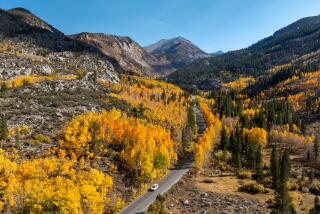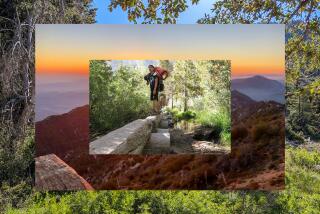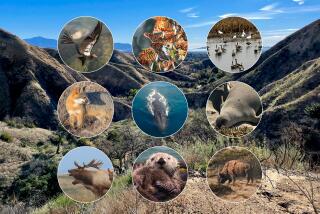Mt. Rainier National Park readies for a wildflower spectacle
MT. RAINIER NATIONAL PARK, Wash. — Right now, Mt. Rainier is snoozing under a thin blanket of snow that probably won’t be gone until after summer officially arrives. But as it melts, it’s setting the stage for a short but spectacular show.
Beginning in mid- to late July, wildflowers burst forth with such abandon that the cruelty of winter is all but forgotten. No wonder the book “Wildflower Wonders: The 50 Best Wildflower Sites in the World” by Bob Gibbons ranks Mt. Rainier National Park as No. 1 for blooms.
The park had been on our travel horizon for years, and we finally decided to make the trek to see whether the horticulture matched the hype. We were spurred by the 2013 publication of “Photographing Washington” by writer-photographer Greg Vaughn, who included detailed descriptions of where to go and what to see in the park. “When the acres and acres of sloping meadows burst into bloom, the scene is truly and memorably spectacular,” Vaughn wrote.
But, he noted, those who visit may be tempted to stray off the marked trails. Don’t do it. “Consider that every step into the meadow squashes an average of 20 plants,” he told us in a phone conversation, “and even if a plant survives the weight of your footstep, its growth may be stunted for years.”
Once you’ve seen the display, you’ll understand why straying and thus stunting or killing is a serious crime against nature. The epicenter of the bloom is Paradise, where the scene unfolded before us in a way that made the words “jaw-dropping” seem like an understatement.
To get here, you could fly to Seattle, rent a car and drive the 100 miles to Paradise. But we, however, chose to drive from L.A. on our July trip. We camped at Cougar Rock, one of three campgrounds accessible by car and the closest to Paradise Meadows. With so many wildflower visitors, the accommodations (nearby and within the park) fill up quickly. And that includes the reservations for the park campgrounds. If you have not booked a place to stay by May, you may not be able to do so; reservations go quickly. To ensure you have a camp site or a room, book now.
We arrived on a clear day and suddenly around a bend in the road loomed the massive, snow-bedecked Mt. Rainier. No wonder it’s known as “The Mountain.” We drove straight to the campground, put up our tent and headed for Paradise Meadows. Within minutes we understood what the excitement was all about each year. Wildflowers and more wildflowers. And more.
There are about 900 species of plants in the park; the park service says only 100 or so are classified as exotic. That may be correct scientifically speaking, but from our perspective they all looked exotic.
Paradise Meadows sprawled across the landscape, dipped into small canyons and twisted around maintained trails. It was a sea of colors: the bluish purple of subalpine lupine, the scarlet and magenta of fiery paintbrush, the splashes of white from American bistort and Sitka valerian. Here and there, bear grass raised its yellow-white head. An occasional breeze caused the flowers to nod their heads like small waves on a larger sea beneath a clear blue sky. While the meadows basked in sunshine, Mt. Rainier may be wrapped in brooding clouds.
Well-maintained trails help hikers explore the meadow and lead to the strenuous climb up the mountain, which isn’t for the casual visitor. Even at the meadow level, the elevation may wind you. We stopped often to take photos and also to catch our breath. We sank often to our knees to photograph the flowers — kneepads helped — but we were continually staggered by what we saw, including Myrtle Falls, a short walk from Paradise Inn.
At day’s end, with visions of what we had seen dancing in our heads, we returned to our campsite where we pulled up a couple of canvas chairs and put our feet up just to relax. Then we tossed something simple on the camp stove — pasta being a favorite — and later slipped into our sleeping bags to prepare for another early morning when the sun bathed the flowers in its glow.
We spent a week in the park, hiking, photographing, taking it all in. It wasn’t enough because, really, you can’t put a time limit on Paradise.
::
Five other prime visual places in and around Mt. Rainier National Park:
Narada Falls: The park’s most popular waterfall is just off the road near Cougar Rock Campground. There is a large, clearly marked parking lot above the waterfall and a moderately steep hike down to reach the base of the falls, which plummet 168 feet. We were lucky and caught the sun illuminating a large rainbow at the falls’ base.
Christine Falls: Another beautiful waterfall, just off the park’s Nisqually-to-Paradise entrance road near Cougar Rock on the way to Paradise Meadows. It is spanned by a perfect rock bridge. It, too, has a parking lot and involves an easy hike to view the falls.
Reflection Lake: Of course, we wanted to capture the iconic view: Mt. Rainier mirrored in the water of Reflection Lake, about a 20-minute drive from Cougar Rock Campground. Photographers gather at the lake before sunrise and wait for the light to illuminate the mountain and create the classic reflection. We spent a couple of very good mornings here, leaving our campsite at 6 a.m. and watching the sun slowly paint the summit of Mt. Rainier, all reflected in the still waters of the lake. The slightest breeze will wipe out the reflection.
Sunrise: We drove to Sunrise by way of Sunrise Road, which begins near the park’s White River entrance, and it was one of the best mountain drives we’ve ever taken. At an elevation of 6,400 feet, this wildflower spot tends to start its big show a bit earlier than Paradise because it gets less snow. Nonetheless some wildflowers — mostly lupine — still were in bloom. A pair of bald eagles circled overhead to complete the wow moments.
Crystal Mountain Resort: This trek required us to leave the park briefly. In winter, Crystal Mountain Resort is a busy ski center, but summer visitors can take a scenic gondola ride to the top of the ski area (we did, and the views were plentiful) and its popular Summit restaurant.
More to Read
Sign up for The Wild
We’ll help you find the best places to hike, bike and run, as well as the perfect silent spots for meditation and yoga.
You may occasionally receive promotional content from the Los Angeles Times.






